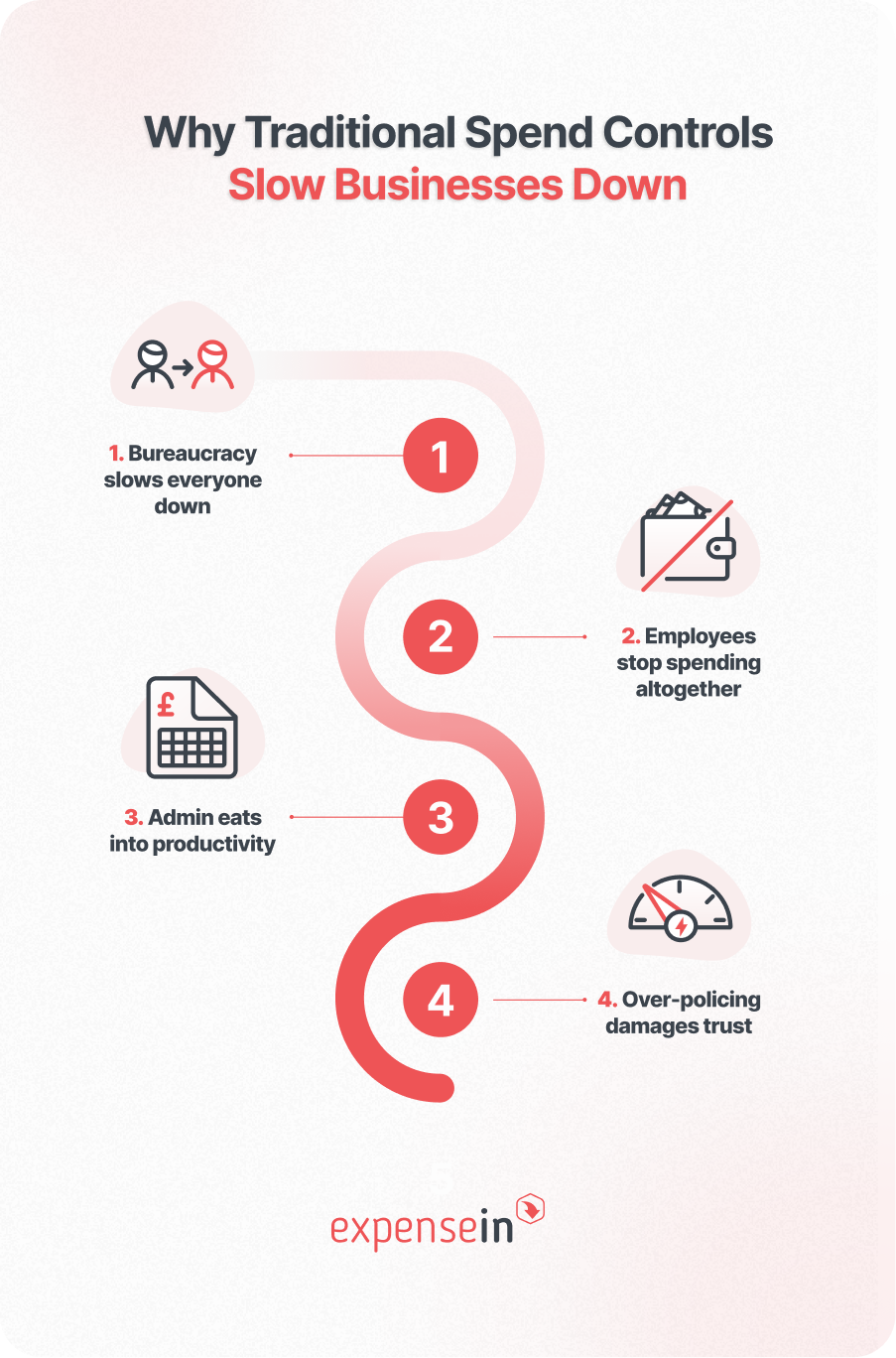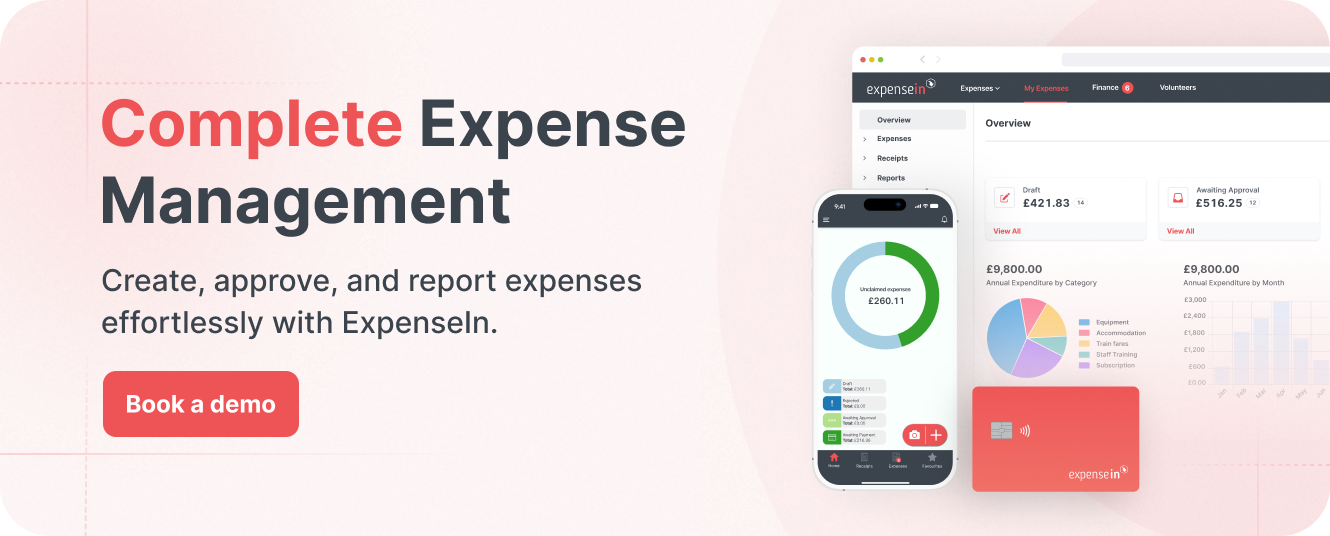If you lead a finance team, you’ve probably seen it happen: every time the business tightens employee spending, everything else seems to grind to a halt.
Approvals stack up. Employees stop booking travel. Managers chase receipts like detectives. And somehow, despite all that effort, the budget still slips.
You’re not alone. More than half of UK CFOs say cost control is their top priority this year, yet many admit their expense processes are slowing the business down instead of saving it money.
So how do you keep spending in check without tying your people in knots?
This article explores how today’s finance teams are doing exactly that: using real-time visibility, finance automation, and smarter processes to stay in control while keeping the business moving.
The Real Cost of Poor Expense Management in the UK
Every finance leader knows manual expense processes are slow, but the real impact goes far beyond inconvenience.
Outdated systems eat up time, create friction for employees, and quietly drain company money.
Let’s put some numbers to it.
Employees are still footing the bill: Nearly half of UK workers (49%) say they’ve used their own money for business purchases, while just 19% have access to a company expense card. That “pay first, claim later” model shifts the cash-flow burden to staff, and often the ones who can least afford it.
Reimbursements take far too long: 43% of employees say they’ve struggled financially while waiting to be repaid, rising to 66% among people who claim expenses regularly. More than 80% have waited over a month to get their money back. It’s demotivating, and it’s no surprise many start avoiding work-related purchases altogether.
Hundreds of millions are slipping through the cracks: Around £690 million in UK work expenses go unclaimed or unpaid each year. Whether it’s confusing expense policies or tedious forms, that’s real money being lost, and it often means lost VAT reclaims too.
Finance teams are stuck chasing paper: Nearly one in three employees gets a weekly nudge for missing receipts, and 28% say their company’s expense process is “highly manual.” That translates to more admin hours, higher processing costs, and a slower month-end close.
Reactive control = risk: Reviewing spend weeks after the fact makes it easy for out-of-policy or fraudulent claims to slip through. UK businesses lose more than £2 billion a year to expense fraud, and with the rise of AI-generated fake receipts, the risk isn’t getting any smaller.
Put simply, a lack of real-time control leaves finance teams reacting instead of managing. You end up firefighting: fixing mistakes and approving expenses long after the money’s already gone.
It’s a broken model that doesn’t work for how modern businesses operate today. Finance leaders need visibility as spending happens, not weeks later, and that means rethinking how expenses are managed from the ground up.
Why Traditional Spend Controls Slow Businesses Down
When spending starts to spiral, the natural reaction is to tighten the reins. More pre-approvals. Stricter policies. Maybe even a spending freeze.
But while those measures might look like control on paper, in practice, they often do the opposite: creating friction, delays, and frustration across the business.
 1. Bureaucracy slows everyone down
1. Bureaucracy slows everyone down
Long approval chains can turn a simple £50 purchase into a week-long ordeal.
Every extra checkpoint adds time, and by the time an expense clears, the opportunity it was meant to support may already have passed.
Teams lose agility, projects stall, and finance still ends up approving things after the fact rather than guiding spend as it happens.
2. Employees stop spending altogether
When claiming expenses feels painful, people simply avoid it.
In one survey, 38% of employees said they’ve skipped legitimate work purchases because they didn’t want the hassle of reclaiming the cost.
That means missed client meetings, postponed business travel, and lost business opportunities – all in the name of control.
3. Admin eats into productivity
Spreadsheets, paper receipts, endless follow-ups: manual expense processes drain time from every level of the business.
Employees waste hours filing expense claims, and finance teams spend even longer chasing receipts or correcting errors. That’s time that could be spent analysing spend or improving cash flow, not wrestling with admin.
4. Over-policing damages trust
When finance rejects claims over minor details or small amounts, it sends the wrong message. Employees start to feel scrutinised or mistrusted, and that tension builds quickly.
Nearly a quarter of workers say disputing a rejected claim is one of the most stressful parts of their job, second only to asking for a pay rise. It’s an avoidable morale killer.
Traditional spend controls tend to slow everything down; they demand more time, more forms, and more approvals, but still leave finance teams blind until the month-end report lands.
The real goal isn’t tighter control. It’s smarter control: building systems that guide employees to spend within policy as they go and give finance instant visibility without all the friction.
Aspect | Traditional Spend Control | Modern Spend Control |
Visibility | Reactive. Finance teams only see spend at month-end. | Real-time. Every transaction is visible as it happens. |
Employee experience | Slow, manual, and frustrating. Reimbursements take weeks. | Seamless and instant. Employees spend easily within limits. |
Approval process | Multiple layers of sign-off, endless email chains. | Smart, rule-based approvals that auto-route and clear instantly. |
Policy enforcement | Checked after submission; high error rate. | Enforced automatically at the point of spend. |
Cards & payments | Generic corporate credit cards with delayed data. | Integrated expense cards with built-in controls and live tracking. |
Compliance & VAT | Risk of missing receipts and invalid claims. | Digital receipts captured at point of spend with full VAT visibility. |
Finance team focus | Reactive. Chasing receipts and reconciling late. | Proactive. Analysing spend and optimising budgets. |
Business impact | Slow operations, poor employee morale. | Controlled, compliant, and agile business spending. |
How to Control Employee Spending Without Slowing the Business Down
Balancing strong spend control with smooth day-to-day operations isn’t easy, but it is possible.
Here are five practical strategies that make a real difference:
1. Set clear expense policies (and make them easy to follow)
Start with clarity.
People can’t follow the rules if they don’t know what they are, or if they’re buried in jargon.
Outline your business expense policy in simple terms:
What employees can and can’t buy
Spend limits by team or role
What requires pre-approval
What evidence is needed (e.g. receipts or VAT invoices)
The more straightforward your policy, the fewer mistakes and approval bottlenecks you’ll deal with. A one-page summary or FAQ can go a long way.
It also helps to train line managers, because employees usually go to their manager first, not finance.
When everyone’s clear on the “rules of the game,” people can spend confidently within policy, without stopping to ask for permission every time they need to book a train or buy supplies.
 2. Streamline approvals with smart controls
2. Streamline approvals with smart controls
Not every purchase needs the same level of scrutiny. Match your approval process to the level of risk.
For example:
Routine, low-value expenses (say, under £20 or within a travel allowance) could auto-approve.
Team leads can sign off on mid-range spends.
Finance reviews only high-value or exceptional cases.
This tiered approach maintains oversight where it matters most, while removing the red tape that slows everything down.
Modern expense management software makes this easy; you can build rules, automate approvals, and set real-time policy checks so out-of-policy items are flagged before the money leaves the account.
That means fewer delays, fewer back-and-forth emails, and faster month-end close.
3. Empower employees with company-funded expense cards
If your employees are still paying out of pocket and waiting weeks for reimbursement, that’s not just inefficient, it’s unfair.
Business expense cards (physical or virtual expense cards) solve that by giving teams access to company funds within set rules and limits. Finance keeps control; employees get autonomy.
You can:
Set spend limits per person or department
Block certain merchant categories
Require instant manager approval for large or unusual transactions
Unlike traditional corporate credit cards that only reveal spend at month-end, smart expense cards give live visibility, so every purchase appears instantly with the amount, vendor, and category.
And when embedded in your expense management system, the transaction becomes the expense report, automatically coded, policy-checked, and ready to approve.
It’s faster, cleaner, and far less stressful. In fact, 83% of UK employees say removing out-of-pocket spending would relieve financial pressure.
4. Automate receipts, reporting, and reconciliation
Manual data entry is the enemy of accuracy and efficiency.
Automation handles the admin, so your team can focus on the numbers that matter.
With today’s expense tracking software, employees can simply snap a receipt, and the mobile expense app reads and logs it automatically.
Finance gets instant visibility, and automated rules flag issues (for example, if an item falls outside policy) before they reach approval. Real-time dashboards show spend by department, project, or category, so you can make adjustments mid-month instead of discovering problems after month-end.
Automation also accelerates expense reimbursements for the few out-of-pocket costs that remain; a small win that makes a big difference to employee satisfaction.
5. Use expense data to continually optimise spending
Expense control isn’t a one-off project; it’s an ongoing process. With good data, it becomes a source of insight.
Look for patterns:
Which teams or suppliers consistently overspend?
Where are policy breaches most common?
Are you missing out on VAT reclaims or volume discounts?
Modern expense systems let you create reports that reveal inefficiencies and opportunities.
Maybe your sales team’s business entertainment budget is creeping up, or three departments are paying separately for the same subscription.
When you treat expense data as business intelligence, you can fine-tune budgets, negotiate better deals, and guide smarter spending.
The Role of Modern Expense Management Software in Spend Control
Smart expense control doesn’t happen through policy alone; it’s powered by the right technology.
Modern platforms bring together everything finance teams need: reporting, approvals, company cards, automation, and real-time data.
That’s exactly what ExpenseIn was designed to do.
As a UK-built expense management software, it gives finance teams complete oversight without adding complexity or slowing employees down.
One platform for every expense: Company expense cards, mileage tracking, travel, and reimbursements all managed in one place, accessible via desktop or app.
Real-time reporting: Every transaction appears instantly with merchant details, receipts, and policy checks attached.
Employee-first experience: A clean, intuitive mobile expenses app that lets staff scan receipts, track mileage via GPS, and submit expenses in seconds.
Smart policy enforcement: Configure your own rules, from spend caps to travel limits, and let ExpenseIn automatically flag or block non-compliant claims before approval.
Flexible approvals: Create multi-level workflows that mirror your organisation. Approve on the go via mobile, set auto-approvals for low-risk spends, and route high-value items to finance.
Business expense cards: Physical and virtual expense cards with built-in controls for limits, merchant categories, and instant freezes.
Effortless reimbursements: Fast-track legitimate out-of-pocket expenses through automated approval and payment flows, cutting the wait time from weeks to days.
Seamless integrations: Syncs directly with AccountsIQ, Sage, Xero, QuickBooks, and more, automatically coding transactions and VAT.
Finance teams stay in control, employees stay productive, and everyone saves time.
 FAQs: Smarter Ways to Control Employee Spending
FAQs: Smarter Ways to Control Employee Spending
By replacing manual processes with automated expense management tools.
Automation enforces policy in real time, routes approvals intelligently, and gives finance instant visibility, so spending stays under control while employees can still get things done quickly.
Look for recurring pain points:
Employees waiting weeks for reimbursement
Managers chasing receipts
Month-end reconciliations that drag on
These are all signs your process is too manual, and costing both time and morale.
Traditional cards only show spend after the fact, which means overspending and policy breaches aren’t caught until it’s too late.
Modern business expense cards, like the ExpenseIn Card, give live transaction data, enforce limits automatically, and sync with your expense platform for instant reconciliation.
Automated expense management systems ensure receipts are captured digitally at the point of purchase, with all the information HMRC requires for valid VAT claims.
You can easily track missing VAT data, flag non-compliant receipts, and export accurate VAT reports straight into your accounting software.
Keep it short, specific, and visible.
Define what can and can’t be claimed, set clear spend caps, and clarify when pre-approval is required.
Embedding your policy inside your expense management tool, like ExpenseIn, means employees see the rules as they spend, not after.
Use expense management tools that apply real-time policy checks and spend limits.
For example, you can restrict certain merchant categories, set daily or monthly limits, and trigger instant manager notifications for higher-value transactions – all before the money leaves the account.
Focus on measurable impact:
Average time to approve and reimburse expenses
Policy breach frequency
% of company-funded vs. reimbursed spend
VAT reclaimed vs. missed opportunities
Admin hours saved per claim cycle
Smarter Spend Control Means a Faster Business
For finance leaders, the challenge isn’t controlling spend; it’s doing it without slowing everyone down.
Outdated, manual processes can’t deliver that balance, but automated expense management can.
With real-time visibility, clear policies, and the right tools in place, finance teams can stay in control while the business keeps moving.
Book a demo to see how ExpenseIn helps finance teams control spend in real time, without the red tape.



